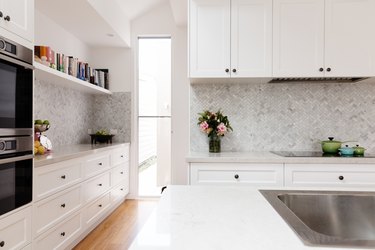
The standard backsplash in the kitchen, the area on the wall above the countertops but beneath the cabinets, generally runs between 15 and 18 inches tall for people of average heights. But more often than not, the backsplash is an afterthought and often is much shorter because of this. Bottom line: No set rules exist as to how high to place the backsplash. In the end, make the backsplash height as tall as necessary to fit your budget, the height of those who use the kitchen and your personal aesthetic.
Purpose of the Backsplash
Video of the Day
The backsplash serves as its name implies; it's an area that takes the hit for splashes and spills that occur in the kitchen from preparing food and cooking it. Backsplashes protect the drywall behind it. Keep this purpose in mind when choosing your height. A 20 inch backsplash extending from the countertop to highly positioned upper cabinets provides a lot more coverage and better protection than an 8 inch backsplash.
Video of the Day
Full or Half Backsplash Height
If you have the standard space of 18 inches between the countertop height and the bottom of the cabinets, a half-height backsplash is one option. It breaks up the space between cabinets and countertop, which some people find visually appealing. Going half the distance also saves on the budget since you'll need fewer materials. If you have samples of the material, hold it up to the wall at half the distance between the countertop and cabinets to see how it looks.
The other common option is installing a full-height backsplash that extends all the way up to the bottom of the cabinets. This creates one solid covering over that gap, which offers more consistency. It also eliminates the harsh break that you get if you stop half way.
Varied Backsplash Heights
When budget's a concern, opt for a short, 4-inch-high backsplash that wraps the material from the countertop up the wall a few short inches, and add tile the rest of the way or paint the wall beneath the cabinets with a semigloss paint for easy cleanup. When choosing the height of the backsplash, take into consideration the size of the kitchen as well as the heights of those who use it.
A small kitchen with a countertop-to-cabinet backsplash might close in the space more than you want. Backsplashes can be 4 inches tall, 8 inches tall, cover the entire distance from the countertops to the cabinets, or stop at half the height of the space.
Behind the Stove
One place where a full-height backsplash works to your advantage is behind the stove with an under-mount microwave above the stove and beneath the cabinets. The height of the backsplash in this area might exceed standard heights, requiring a taller section of backsplash. Because cooking can be messy, the area behind the stove benefits from the easy-to-clean surface a backsplash provides. Even if you install a half-height backsplash in the rest of the kitchen, add a full-height one here.
Backsplash Material Considerations
Backsplash materials can be the same as those on the countertop, such as tile, solid-surface granite, an engineered solid-surface product or a completely different material, depending on the look you want. If you want the backsplash to be there but disappear, match it to the materials used in the countertop for a cohesive look, essentially extending the countertop to the backsplash. Homeowners have also installed copper, pressed tin, pebbles, wood, colored glass and even real bricks, but at a much reduced thickness.
The material for the backsplash is a personal aesthetic, chosen for its durability and overall appearance. The material can also influence the height of the backsplash. If you use 4-inch tiles, you might do two rows to create an 8-inch backsplash, for example. Consider the size of the backsplash material and how it logically makes sense to break it up.
Read more: Ideas for a Tile Backsplash in the Kitchen